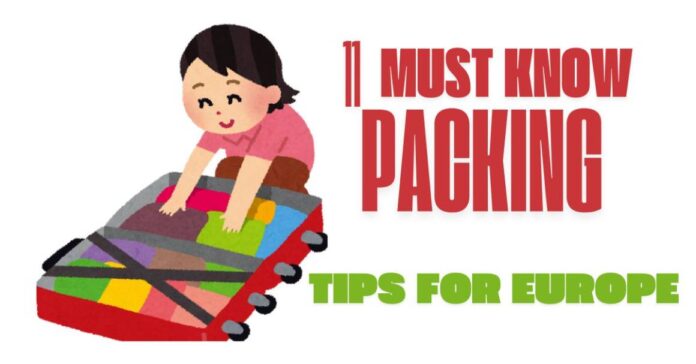When we think about packing for Europe Trip , it can be very overwhelming but the point is this preparation does not need to be super stressful. From ensuring your luggage stands out to packing practical shoes, In this article we will take you through the 11 must-know tips while packing. It does not matter whether you’re a seasoned traveler or you are heading to Europe for the first time, these must known tips can help you make your trip smoother and more enjoyable.
1. Make Your Luggage Unique
A common mistake that every traveler make is not choosing to personalize their luggage to distinguish. Let’s say you have a popular brand or color of suitcase, now when you reach airport , you can see that there are a lot of people who are probably using same color or same brand so it’s easy for your bag to get mixed up with others at airports or train stations. That’s why it is must to attach unique identifiers such as a bold luggage tag, colorful straps, or stickers to your luggage so that you can find out if your luggage get mixed up. This is a very simple step but it is very very helpful because it can save you from the hassle of someone accidentally taking your bag, as happened to me once. Since then, I’ve ensured every suitcase I own has an uniqueness attached to it unmistakably.
2. Choose a Bag You Can Carry
It’s of utmost importance that you bring such luggage that you can comfortably lift and carry. Whether it’s lifting your suitcase onto a train or carrying it upstairs when elevators are not available, you need to first ensure that you’re physically capable of handling your bags without tiring you much. Consider practising lifting your luggage at home just to gauge its weight. While many people recommend using backpacks over suitcases due to Europe’s cobblestone streets, a high-quality rolling suitcase works just as well. Consider investing in durable luggage like my trusty Delsey suitcase which is equipped of handling cobblestones effortlessly for years.
3. Pack for Unpredictable Weather
The weather in Europecan be highly unpredictable, so make sure that you don’t pack exclusively for the season you’re visiting. Bring a light jacket or a raincoat even when you are visiting in Summer. I had to learn this the hard way during a May trip to southern Italy, when I got caught up in unexpected thunderstorms without a rain jacket. Be mentally prepared for any sudden changes in weather and make sure that you pack layers to stay comfortable no matter what happens.
4. Bring the Right Adapter

Most European countries use the Type-C plug, but some, like the UK and Malta, use a different type. Invest in a universal travel adapter that covers multiple plug types and includes USB ports for charging multiple devices simultaneously. This is particularly useful in accommodations with limited power outlets. Remember, adapters only change the plug shape—they don’t convert voltage. If you’re bringing single-voltage devices like hair tools, you’ll need a converter or dual-voltage appliances.
5. Avoid Brand-New Clothes and Shoes
It is essential that you test your wardrobe before long haul traveling. Wearing New clothes may seem exciting to you , but they can also be uncomfortable especially when they don’t fit well or you feel that the fabric isn’t breathable. The Journey becomes uncomfrotable. The same goes for shoes— consider not packing any brand-new ones unless you’ve worn it thoroughly considering it can cut your feet. Europe has cobblestone streets which makes it necessary to put on comfortable walking shoes for long sight seeing trips and long sightseeing days. You may choose white sneakers, like my Nike Air Force 1, which are stylish and practical.
6. Leave Room for Souvenirs
Many travelers forget to leave space for souvenirs or shopping which they seem to enjoy a lot and get lost in it. If you’re planning to bring back items, do make sure that your suitcase isn’t packed to its fullest capacity. Alternatively, you can also choose tobring a foldable duffel bag with you to carry the shopped items. This will help you to expand your luggage only for the return trip and you can also ensure that you are not charged any extra baggage fees on your way out.
7. Pack a Practical Day Bag
Choose a lightweight crossbody bag instead of a large backpack while going for daily sightseeing. Crossbody bags are easier to manage when you are travelling in crowded spaces or on public transport. Plus you can also keep your belongings in front of you whish results in reduction of pick pocket or theft. Museums often require visitors to store their larger bags in lockers. Therefore it is convenient to carry smaller bags.
8. Secure Your Phone

It is very common to use phone frequently for photos, navigation, and communication. Therefore you should consider getting a phone strap so that you can keep your device easily accessible and secure. Phone theft is very common these days in busy European cities, so this added layer of security is invaluable when it comes to safety. Jackets with inner pockets can also be a safe and convenient storage option.
9. Embrace Being a Tourist
Many travelers try too hard to blend in with locals, but it’s not at all necessary. it is important that you dress respectfully and appropriately for your destination rather than trying to avoid the “tourist” label. While overly casual clothing like athleisure isn’t common in European restaurants or museums, dressing slightly dressier ensures a positive impression and better treatment. Choose outfits that are comfortable yet polished.
10. Prioritize Comfort Over Style
Practicality should be considered foremost when packing for Europe. While it is very unresistable to bring the cutest outfits and shoes, one must ensure that they’re functional for walking, stairs, and uneven streets. Choose heels when you’re attending a special event, or else go with versatile footwear.
11. Plan for Electronics
Modern devices like phones, tablets, and laptops are often multi-voltage, so they don’t require a converter. However, older or single-voltage devices, like some hair tools, may need one. If you travel frequently, consider investing in dual-voltage appliances to avoid the need for a bulky converter.
Have you made any of these packing mistakes before? Share your experiences and tips in the comments below!
For More such articles , visit stayvibes.com.

